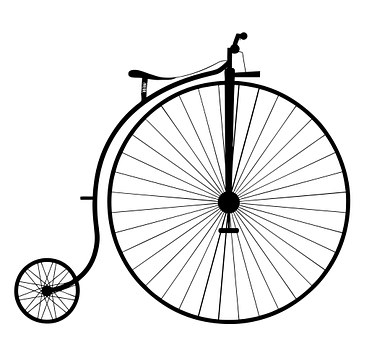This week's Sepia Saturday
photograph features a group c.1900 standing proudly beside their bicycles. The prompt made made me take a look at the topic of women on
wheels - or as, one journalist in the 1890's called them,
"wheelwomen".

"Velocipedes" were an early form of bicycle, followed by the penny farthing and the boneshaker.



The introduction of the "safety bicycle" brought in the first hey days
for leisure cycling in the 1890's, with women not going to be left
behind. For women, cycling came to represent a freedom they had not
experienced before and the activity quickly became associated with the
wider movement of women's emancipation.
But there were public outcries at the prospect of these changes in the social norm with much of the criticism focusing on women's dress - notably the new style of bloomers and knickerbockers. these offered more freedom for movemen than women's usual restrictive dresses. These fashions became the subject of ridicule in cartoon of the time.

Newspapers
of the day ** abound with letters, articles and reports on the
vision of women riding around the countryside. In 1894, the Society of
Cyclists called for "Rational Dress for Wheelwomen"An angry letter condemned "A
young woman who spends most of her time in riding on a man's bicycle,
has a good deal to learn in respect of simplicity and neatness of
attire". A clergyman refused to give communion to women who turned up for church in bloomers or knickerbockers.
However some doctors said firmly that, "As those best qualified to judge, they were almost unanimous in declaring that the average standard of health among women, who cycle had shown an appreciable elevation."
So this was the image portrayed in advertisements and posters that conveyed a sense of fun and freedom. with illustrations of happy cyclist enjoying the fresh air and exercise.
As one protagonist said "A most exciting and delightful mode of travel."

Images above courtesy of Pixabay. Sources of quotes: Find My Past British Newspapers Online
****************
Below cycling photographs from my local and family history group Auld Earlston :


 Three photogrpahs of women cyslists in Earlston in the Scottish Borders.
Three photogrpahs of women cyslists in Earlston in the Scottish Borders.



But
what of my ancestors - next to no photographs exist of them on bikes.
My grandfather cycled or walked everywhere until he died. For years,
my aunt cycled in all weathers more than five miles to her work as a
teacher on a bike with a basket on the front handle bars. When I came
to get my first bike, the basket like hers was a "must have" item, along
with a bell.
Here is my husband's great Aunt Pat who during the Second World War rode on her bicycle to work with the Fire Service in Kent on the south coast.
Fast forward more than 110 years from the first image, and here is my granddaughter in the casual dress of the day, plus the obligatory helmet as "health and safety" considerations reign supreme. What a contrast!
Adapted from a post I first published in 2017.
**************
Sepia Saturday gives bloggers an opportunity to share
their family history and memories through photographs.
their family history and memories through photographs.




You've covered several aspects of bike riding - especially for women - from the earliest days to the present with changing fashions & ideas of who should be riding bicycles to today's children who, no matter how small, bypass the tricycle & go straight to the two-wheeler with training wheels & a helmet, of course. :)
ReplyDeleteBeing Dutch, the Dutch flags in your first picture drew my attention. On the flags, it says ‘lichtloopend’ (running smoothly) and ‘betrouwbaar’ (reliable).
ReplyDeleteThe gentleman in the second picture thought it ok to read a newspaper when driving. People still do that with their mobiles causing many accidents! But now we know the origin of this bad habit ;-)
Thank you for sharing this nice collection of 'velocipedes' (in Dutch: rijwiel, fiets).
So many romantic images of bicycles and bicyclists. I like your husband's great aunt's uniform. The penny farthing is a favorite vehicle of mine, though I wouldn't want to ride one.
ReplyDeleteSusan
This was a terrific post on early cycling. Many years ago when I first visited Britain, a friend and future wife invited me to her holiday cottage in the tiny village of Weardale in the Pennines. On a hike over the hills one day we met an elderly woman who was native to the village. As our conversation turned to traveling and hiking the area, she told us the story of how liberated she felt when she got her first bicycle back in 1920s/30s. I remember how her face beamed with delight at recalling the memory of being able to cycle down the valley to reach shops and friends. We forget that in remote rural areas it was the bicycle, not the automobile, that opened up the world for many country folk.
ReplyDeleteYou have ably captured the freedom that cycling offered women -- the ability to get around on their own and to build health and strength in the process. I was an avid bicycle commuter in my 20s and 30s and never had to go to the gym! Let's hear it for those doctors who stepped up in support of women cycling for health.
ReplyDelete